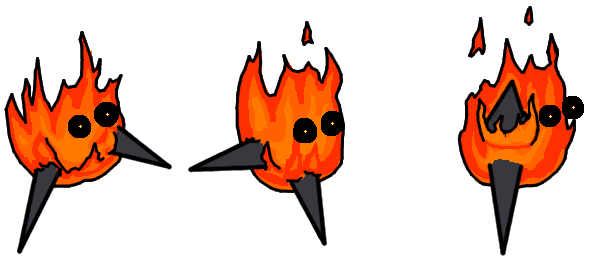How the art of T-SOL is made!
During the development of T-SOL so far I've found that content development, not code, is the most time consuming part of creation. In light of that I figured I could walk you all through how some of the art for T-SOL is created.
Each original character, tile or piece of scenery starts life as a sketch on a piece of paper. Usually I'll start out by filling a sheet with many sketches of different enemy type ideas. Once I've settled on a set that I like I'll re-draw them with shading to show roughly how they should look in game. This is also the stage where I will sketch out all the keyframes for a character. I don't worry too much about getting every frame consistent since it's easier to manage that on the computer.

After scanning I'll open the images in Glimpse and cut up the sketch into pieces, generally each frame is turned into a layer which is put into its own layer group. I'll then add two additional layers to each group. One for outlines and one for colours.
Once all the boring stuff is done it's time to trace the pencil art. The outline size varies to give depth to the enemy and to help make sure each part is distinct from its surrounding parts. A thinner line reduces the amount of separation between sections of the image. The character visually breaks into parts made of thinner lines separated by the thicker lines. If the character I'm drawing is animated I'll overlap the frame I'm drawing with the frame before it to make sure the doesn't look weird. After that I'll block in colours without shading.

Normally I'll import the art into Unity after blocking in is done. It's far easier to check if the colours and animations look right in the game before I do shading. If something needs tweaking it simply means adjusting the outline and basic colour without having to re-do all of the details too.
The final stage is shading and details. This is the slowest part and often the most variable in how it's done. I normally use either three or five shades of each colour on an enemy. For most, I use three, the base colour, which was placed during blocking in, a shadowed colour and a highlighted colour. If the enemy is large or detailed there may be one more shade for shadows and one more for highlights.

And that's it. Pretty much. I'll be posting some in-game screenshots in the near future.
Get T-SOL - Early Access Demo
T-SOL - Early Access Demo
An accident has left Saul marooned on an unfamiliar planet. Help get Saul home!
| Status | In development |
| Authors | Bird With Toes, Tofski |
| Genre | Platformer |
| Tags | 2D, Metroidvania, Short |
More posts
- Update 5 NOW AVAILABLE!Sep 10, 2023
- Plans for Update 5Aug 01, 2023
- Unity 2D Animation with Fancy Lighting!Aug 01, 2023
- Update 4 Released Development ResumedJul 16, 2023
- Customized Tiles in UnityJun 21, 2021
- The Light of Forgotten PromisesJun 01, 2021
- Plans for Update 4May 10, 2021
- Update 3 now Available for Download!May 04, 2021
- Update 3 will be available Tomorrow!May 03, 2021
Leave a comment
Log in with itch.io to leave a comment.